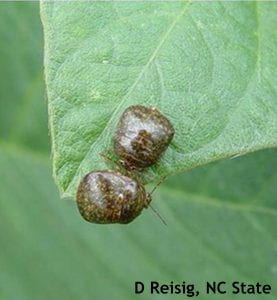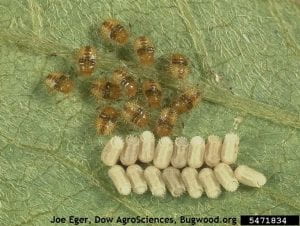Joanne Whalen, Extension IPM Specialist; jwhalen@udel.edu
Alfalfa
Continue to sample for potato leafhoppers on a weekly basis. We are continuing to find fields with yellowing from leafhopper feeding damage. Once plants are yellow, yield loss has already occurred. The treatment thresholds are 20 per 100 sweeps on alfalfa 3 inches or less in height, 50 per 100 sweeps in 4-6 inch tall alfalfa and 100 per 100 sweeps in 7-11 inch tall alfalfa.
Field Corn
The two most common insects currently being found on fields in the silk stage are Japanese beetles and brown stink bugs. The following are general guidelines for management of these two insect pests in silking field corn:
(a) Japanese Beetle – Treatment may be needed if silks are clipped back to less than ½ inch before 50% pollination and beetles are present and actively feeding. Pollen shed for an individual tassel generally takes 2-7 days to complete and 1-2 weeks for an entire field (information from Bob Nielson, Purdue University).
(b)Stink Bugs – During the pollination to blister stages (R1 – R3), stink bugs feed through the husk and damage individual kernels. Control may be needed if you find an average count of one bug per plant.
Soybeans
We can find a variety of defoliators in soybean fields including grasshoppers, green cloverworm, oriental beetles and Japanese beetles. In general, a treatment decision should be based on percent defoliation. Before bloom, the defoliation threshold in full season soybeans is 30% defoliation. Once fields reach the bloom stage, this threshold decreases to 15% defoliation.
Now that the first Kudzu bug adult has been detected in the state, it is important that you know how to identify all stages of the bug as well as learn about proper sampling techniques. As indicated last week, although there are new thresholds for adult Kudzu bugs that are now available on seedling stage soybeans, the most important time to control this insect is when the first nymphs are detected so looking for egg masses will be important as well. A threshold of one immature nymph (big enough to see) per sweep should be used in fields that are flowering or developing pods. Below are a few photos to help with identification. You can also go to http://www.kudzubug.org/ for more information on identification and management.
Here are some guidelines from Dominic Reisig from NC State that should be help to ensure you are doing a good job sampling fields:
“ 1) Take 15 – 20 sweeps per sample away from field edges.
2) Try to get the net as low as possible between sweeps to hit the middle portion of the plant. More than a half of the insects are located this section of the plant.
3) Kudzu bug is more active from 11AM to 2PM, resting near the bottom of the plant in quiescent times in the morning and late afternoon and evening. To facilitate capture and reduce the chance of underestimate adult population, scout during the midday period above.
4) Look closely at the bottom of the sweep net because nymphs cluster in this section of the net. “
For more information please refer to the following link : http://www.nccrops.com/2013/07/10/scouting-kudzu-bug/


